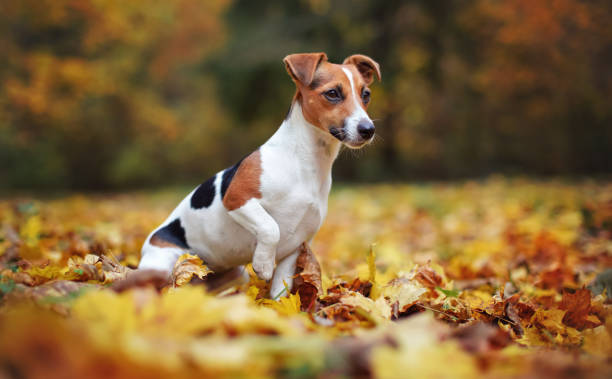Jack Russell Terrier

Breed History:
The Jack Russell Terrier traces its origins to early 19th‐century Devonshire, England, when Reverend John Russell set out to breed terriers specifically for fox hunting. In 1819, he acquired a white female terrier named Trump, whose traits formed the basis for his line of agile, determined hunting dogs. Bred to flush foxes from their dens without harming them, these compact and flexible dogs quickly gained a reputation for intelligence and tenacity. Over the decades, while various strains evolved—including the longer-legged Parson Russell Terrier—the original working spirit of the Jack Russell has endured.
Height – 25-30 cm
Weight – 5-6 kg
Size – Small
Life Expectancy: 12-13 years

Breed Appearance:
Jack Russell Terriers are predominantly white, accented by distinctive black, brown, or tan markings. Their coat may be smooth, rough, or a combination of both. These dogs possess a well-proportioned head that is moderately wide at the ears, tapering gracefully toward lively, almond-shaped eyes. The transition between the muzzle and the head features a subtle stop, emphasising a strong, well-boned jaw with a scissor bite and straight teeth. They typically have a black nose and small, V-shaped ears that point forward.
Breed Type - Family/guard:
As family dogs, Jack Russells are energetic, intelligent, and playful companions that thrive in active households. With proper exercise and socialisation, they bond well with family members, offering affection and lively entertainment.
As guard dogs, these terriers may be small, but their fearless, alert, and vocal nature makes them excellent watchdogs. Bred for fox hunting, they possess a keen sense of their surroundings and will promptly signal any unusual activity.

Training:
Smart but strong-willed:
-
Highly intelligent and quick to learn
-
Needs early obedience and socialisation
-
Responds best to positive reinforcement and variety in training
-
Can become bored or mischievous if under-stimulated
-
May display stubborn or dominant behaviours without structure
Consistent rules, patience, and plenty of mental stimulation are essential.
Health & Care:
Generally healthy, but may be prone to:
-
Patellar luxation (loose kneecaps)
-
Deafness, especially in mostly white dogs
-
Lens luxation or cataracts
-
Legg-Calvé-Perthes disease (hip joint issues)
-
Dental crowding in small jaws
Routine vet checks, dental hygiene, and early screening are recommended.

Living Conditions:
JRTs can adapt well if exercised:
-
Suitable for apartments or homes with enough mental and physical activity
-
Needs a secure yard—they are escape artists and diggers
-
Not ideal for homes with small pets like hamsters or rabbits
-
Can be great with older children, but too rough for toddlers
-
May be territorial or reactive with unfamiliar dogs
A structured environment and plenty of outlets for energy are key.
Exercise:
Extremely high energy:
-
Needs at least 60–90 minutes of exercise daily
-
Loves fetch, agility, hiking, and digging
-
Craves mental tasks—trick training, scent games, and puzzles
-
Without stimulation, it can become destructive or hyperactive
Best suited to active owners who can match their energy.
Grooming:
Low to moderate maintenance:
-
Weekly brushing (more often for rough coats)
-
Minimal odor and seasonal shedding
-
Occasional baths and ear cleaning
-
Nail trimming and dental care are important for health
They’re easy to groom but need regular handling to stay comfortable.

Advantages:
-
Extremely energetic and playful – great for active owners
-
Highly intelligent and quick learner
-
Bold, confident, and full of personality
-
Loyal and affectionate with family
-
Small size – suitable for apartments with proper exercise
-
Excellent watchdog – alert and vocal
-
Generally healthy and long-lived
Disadvantages:
-
High energy levels require daily physical and mental stimulation
-
Can be very stubborn and strong-willed
-
Prone to excessive barking if not properly trained
-
Strong prey drive – may chase smaller animals
-
Not ideal for families with very young children or passive owners
-
Needs firm, consistent training and boundaries
-
Can become destructive or anxious if bored or under-stimulated







